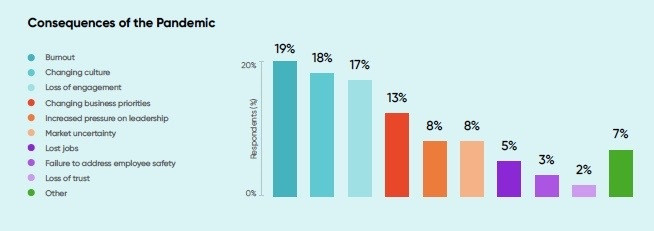What is Mental Health and Wellness in HR?
Posted: May 23, 2022

Mental health and wellness in HR are becoming top priorities for employers. In fact, HR leaders named mental health and wellbeing as their third biggest problem, behind the labor shortage and retaining talent, in the latest HR Exchange Network State of HR report. In addition, those surveyed also said burnout was the top consequence of the pandemic. “Blurring of work and personal life” and “burnout” tied, with 28% of the vote each, as the biggest challenges to employee engagement. And 30% of respondents said employee engagement and experience was their top priority.
Clearly, mental health and wellness is related to the employee experience, and the expectations in the new normal require HR leaders to provide support, empathy, and guidance for helping those who need it. To begin, they need to understand the nuances of mental health and wellness.

Defining Mental Health and Wellness
A first step for HR leaders is to breakdown mental health and wellness to understand the differences, so they can best address “mental health” and “wellness.”
What Is Mental Health?
The U.S. government defines mental health as the emotional, psychological, and social wellbeing of an individual. Obviously, one’s mental health contributes to how he thinks, feels, and acts, and it relates to his resiliency and relationships with others.
Considering this definition, HR leaders can focus on insurance that covers mental health conditions and connecting people to appropriate specialists just as they would for employees with physical ailments, for example. Tending to mental health needs is slightly different than those of wellness.
What Is Wellness?
On the other hand, wellness refers to the totality of health – both mental and physical – of an employee, according to the Society for Human Resource Management. When employers focus on wellness, they are aiming to provide employees with preventative solutions to avoid illnesses and long-term health problems. For example, gym memberships, yoga classes, and meditation sessions are among the ways HR leaders may support the wellness of workers.
Mental health refers to the condition of an employee’s state of mind, whereas wellness refers to his or her general health. Sometimes, even those in HR use the word wellbeing interchangeably with wellness, but there is a distinction. Wellbeing refers to job satisfaction or one’s contentment at work. Certainly, wellbeing is related to mental health and wellness. If employees are experiencing anxiety, high stress, or burnout, which are associated with both mental health and wellness, they may experience negative feelings at work. Therefore, their wellbeing also will be at risk.
HR’s Responsibility for Mental Health and Wellness
The pandemic revealed the need for mental health and wellness programs at workplaces. Both mind and body needed soothing, and HR professionals took the lead in providing solutions to workers. More than two years after the start of the pandemic, they are continuing to enhance their offerings.
Here are some relevant benefits that employers may provide, and HR leaders can consider:
Medical Insurance that Covers Mental Health
This first benefit is the most obvious one, and it refers to the employer choosing insurance options that cover mental health as robustly as they do physical health.
Employee Assistance Programs (EAP)
The U.S. government defines an EAP as a “voluntary, work-based program that offers free and confidential assessments, short-term counseling, referrals, and follow-up services to employees who have personal and/or work-related problems.” These programs may address stress, substance abuse, or family discord, for example.
Mental Health First Aiders
This is a professional who works on staff or on call for a business, so employees always have someone to support them with any mental health concerns, according to verywellhealth.
Training for Managers, Leaders, and Peers
Some companies are training their teams to recognize potential mental health issues in their colleagues and to develop empathy and emotional IQ.
Yoga, Meditation, Workshops, Zen Rooms, etc.
These are a few examples of programs designed to help employees relieve stress and stay focused.
Mental Health Days
Some companies are including mental health days in their paid time off menu. This allows people the chance to stay home as they would for a sick day.
Parameters around Work Hours/Flexibility/Respecting People’s Time
Many employers are sharing guidelines about allowing employees flexibility around when and where they work or during what hours they can communicate with them about work, etc. The idea is to help people better balance work and life to give them the time and space necessary to recharge.
Why Should HR Leaders Care about Mental Health and Wellness?
The answer about why any leader should care about employees’ wellness seems obvious. It’s the right thing to do. But it also relates to business outcomes. Poor mental health and wellness among employees can pose grave risks to an employer. These are the threats:
- Decreased Productivity – People are not as interested in getting the job done if they’re dealing with mental health issues.
- Resignation – Mental health and wellness is clearly connected to job satisfaction and wellbeing. People might quit if they are suffering.
- Negative Impact on the Bottom Line – If employees are not productive or engaged, the company will not be as successful. If there is much turnover, the company will lose money in recruiting, hiring, training, and patiently waiting for new hires to get up to speed. All these consequences can influence revenue and business outcomes.
How Work Can Affect Employee Wellness
Employees spend a large amount of time working. Toxic workplaces obviously can damage one’s mental state, whereas a psychologically safe environment can motivate people. Anyone experiencing bullying or harassment at work may feel more anxiety or stress. That’s undoubtedly true. But having heavy workloads, tight deadlines, and other stressful personal situations can lead to burnout. Potentially, these factors cut into the psychological contract between employee and employer. This is concerning to HR leaders.
The Mayo Clinic says job burnout is a type of work-related stress that results in a state of physical or emotional exhaustion that can influence an employee’s self-worth and sense of identity. The pandemic and consequential labor shortage put burnout in the spotlight and forced employers to confront it. Now, HR leaders are working to combat and prevent burnout as part of their overall mental health and wellness strategies.
Taking steps to reduce hours and workloads, managing expectations, and training managers to be better, more empathetic leaders are among the ways they are addressing the problem. HR Exchange Network recognized this new obligation of Human Resources in its recent talent management report:
Companies that show they truly care about the mental health and wellness of their employees will get noticed. Those who are flexible and understanding when people are having a tough time personally will win hearts. “Companies need to switch their focus on engagement to experience. Maya Angelou said it the best, ‘People forget what you tell them. They don’t forget how you make them feel,'” says Sebastien Girard, Chief People Officer at Centura Health.
HR leaders are helming efforts to address mental health and wellness of employees. They are confronting these issues to improve employee engagement and experience and the work culture. Employers recognize the link between the mental health and wellness of their employees and the success of their business.
In addition, they realize this is the right thing to do, which is vital at a time when employer brand is of the utmost importance, and everyone is trying to better maintain work-life balance. The pandemic was the spark for employers giving attention to these issues, but the focus on helping employees maintain their mental health and wellness will continue.
By Francesca Di Meglio
Originally posted on HR Exchange Network
